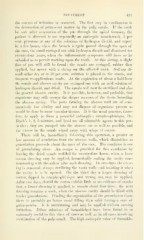Page 493 - My FlipBook
P. 493
TREATMENT. 491
the sources of irritation be removed. The first step in sterilization is
the destruction of putrescent matter in the pulp canals. If the tooth
be sore after evacuation of the pus through the apical foramen, the
patient is directed to use repeatedly an antiseptic mouth-wash, 3 per
cent, pyrozone or any of the solutions of hydrogen dioxid, and report
in a few hours, when the broach is again passed through the apex of
the root, the canal syringed out M'ith hydrogen dioxid and dismissed for
twenty-four hours, when the inflammatory symptoms will have so far
subsided as to permit working upon the tooth. At this sitting, a slight
flow of pus will still be found ; the canals are syringed, rubber dam
applied, but never with a clamp on the affected tooth. Sodium di-
oxid either dry or in 50 per cent, solution is placed in the canals, and
frequent re-applications made. At the expiration of about a half-hour
the canals and abscess cavity are syringed out with an acid solution of
hydrogen dioxid, and dried. The canals will now be sterilized and also
the general abscess cavity. It is possible, however, and probable, that
organisms may still occupy the deeper recesses of the tissue bounding
the abscess cavity. The parts forming the abscess wall are of com-
paratively low vitality and may not dispose of organisms present as
would be done in more vascular tissues. It is the usual practice, there-
fore, to apply to them a powerful antiseptic : campho-phenique, Dr.
Black's 1, 2, 3 mixture, and lysul are all admirable agents in this par-
ticular ; they are pumped into the abscess sac as well as possible, and
the excess in the canals wiped away with wisps of cotton.
There will be, immediately following this operation, a greater or
less amount of exudation from the abscess walls, which diminishes as
granulation proceeds about the apex of the root. The condition is one
of granulating ulcer. An escape is provided for this exudation by
leaving the dried canals unfilled for twenty-four hours, when a loose
cotton dressing may be applied, hermetically sealing the cavity com-
municating with the saliva after each dressing. In two days the dress-
ing is removed, always sterilizing the tooth walls and isolating it when
the cavity is to be opened. On the third day a larger dressing of
cotton, dipped in campho-phenique and wrung out, may be applied.
After two days, should the cotton exhibit little or no evidence of exuda-
the next
tion, a firmer dressing is applied, to remain about four days ;
dressing remains a week, when the abscess cavity should be filled with
tender granulations. Pending the organization of the granulation tissue
there is probably no better canal filling than salol having a core of
gutta-percha. It is unirritating and may be a})plied without causing
irritation. Dilute solutions of formaldehyd have been found to be
extremely useful in this class of cases as Avell as in all cases involving
sterilization of the pulp canal. The high antiseptic value of formalde-


